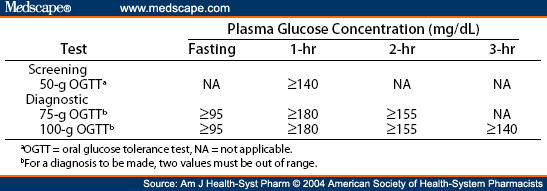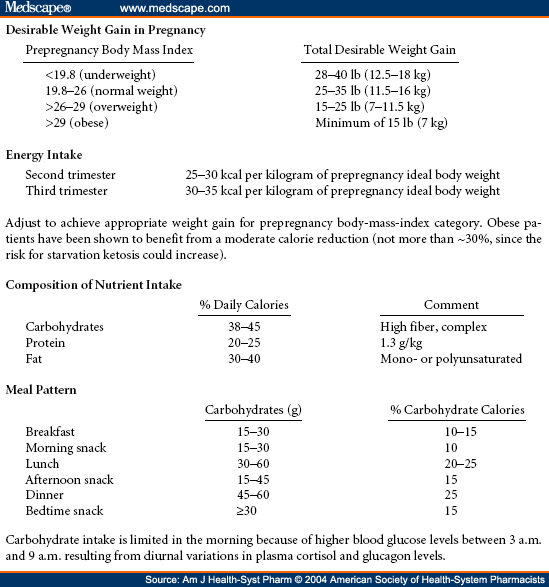Setting up a Pharmacist-Run GDM Education Service
A pharmacist interested in developing a GDM education service must first assess the feasibility of providing such education in his or her practice setting. A private area with no distractions is necessary for one-on-one patient counseling. The pharmacist should also determine whether such a program is needed in the practice setting. This assessment can be completed by talking with local physicians, clinic administrators, and patients. If a GDM education service is feasible and needed, the pharmacist must develop a curriculum. Well-established guidelines can be adapted to educate patients with GDM. Table lists the points that should be covered by an educational program according to ADA.[27]
The pharmacist must also market the service to local physicians and clinics in order to obtain patient referrals. Depending on budgetary and time constraints, marketing can range from mailing letters or fliers to the medical staff to providing inservice sessions about GDM. The pharmacist should stress that the program is intended to support the team involved in caring for these patients, not to be a replacement for current care.
As patients are referred, a medical record should be established that includes relevant patient data, education received by the patient, and questions asked by the patient. If blood glucose testing is performed during the educational visit, the result of that test should be recorded, along with the dates of any follow-up appointments. At the end of the session, a letter summarizing all this information should be sent to the referring physician.
Assuming that there is an established patient care or private counseling area in the location where the education is to take place, start-up costs are minimal, with the pharmacist's time being the most costly resource. The pharmacist will have to spend time away from the daily practice in order to actively market the service to local physicians, clinics, and third-party payers; prepare written materials to give to referred patients; and perform the counseling. It will also be necessary for the pharmacist to vigorously pursue favorable contracts with suppliers of blood glucose-testing supplies, especially since the profit from these supplies is more reliable than reimbursement for education from third-party payers. One suggested strategy is to charge the patient a set fee upfront, then submit a claim on the patient's behalf with the understanding that the insurance company may or may not send the patient a reimbursement check.
While only sites that are recognized by ADA can currently obtain reimbursement from Medicare for diabetes education, many pharmacists across the country have, after aggressive marketing campaigns, been able to obtain compensation for patient education and cognitive services from other third-party payers if they complete certain credentialing or certification procedures. Depending on the patient population, some pharmacists may choose to charge patients directly. If the primary method of reimbursement for a GDM education program will be self-payment, the pharmacist must be able to calculate the service cost, or the cost to the pharmacy of one patient encounter. A good discussion of service-cost calculation is provided by Carroll.[28] The components of a service-cost calculation can include
|
These expenses can then be divided into three basic categories: direct costs, salaries, and indirect costs. Direct costs are those that would not be incurred if the GDM service was not offered, such as promotion expenses and the depreciation for any renovations needed. Salary costs are for time spent on all aspects of the education program, including direct patient care, documentation, and patient follow-up. Indirect costs are those that would be incurred even if the service was not offered. Indirect costs can be allocated by using either the ratio of the square footage of the space to be occupied by the service to the total square footage of the pharmacy or the ratio of the number of hours spent by the pharmacist on GDM activities to the total number of hours worked. Examples of allocated expenses are rent, utilities, insurance, telephones, and computers.
Once all the relevant expenses have been identified and categorized, the service cost of one educational session can be calculated as the sum of direct costs plus salary costs plus indirect costs divided by estimated number of sessions. For the service to produce a profit, the price to the patient must exceed the service cost. Two critical factors determine the financial success of a GDM education service. The first is a reasonably accurate estimate of the volume of GDM sessions that will be billed. This estimate can be derived from market analysis, sales calls to physicians, or surveys of existing customers. The second critical factor is the labor cost per GDM education session.
Am J Health Syst Pharm. 2004;61(14) © 2004 American Society of Health-System Pharmacists
Cite this: Management of Gestational Diabetes Mellitus and Pharmacists' Role in Patient Education - Medscape - Jul 15, 2004.






Comments